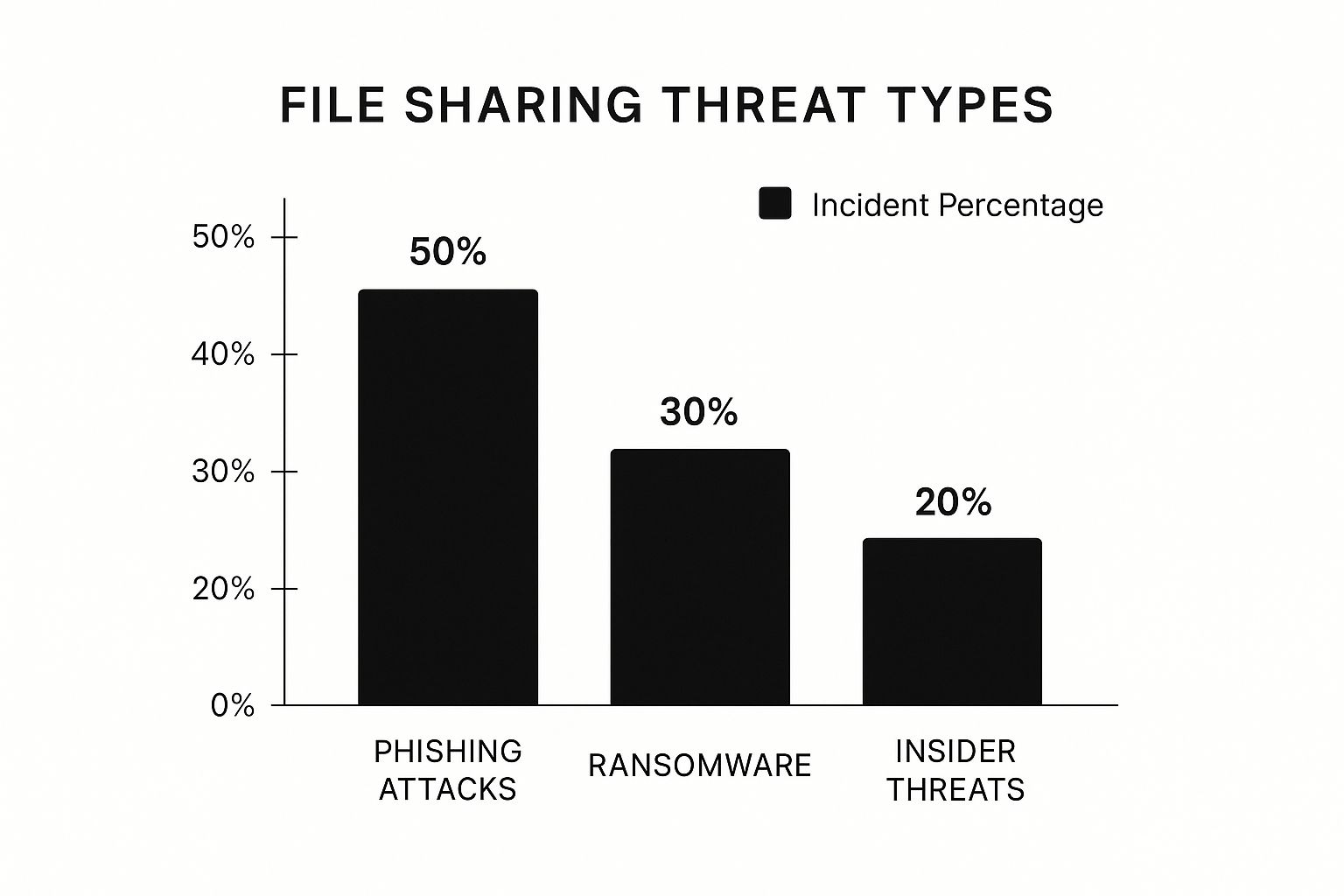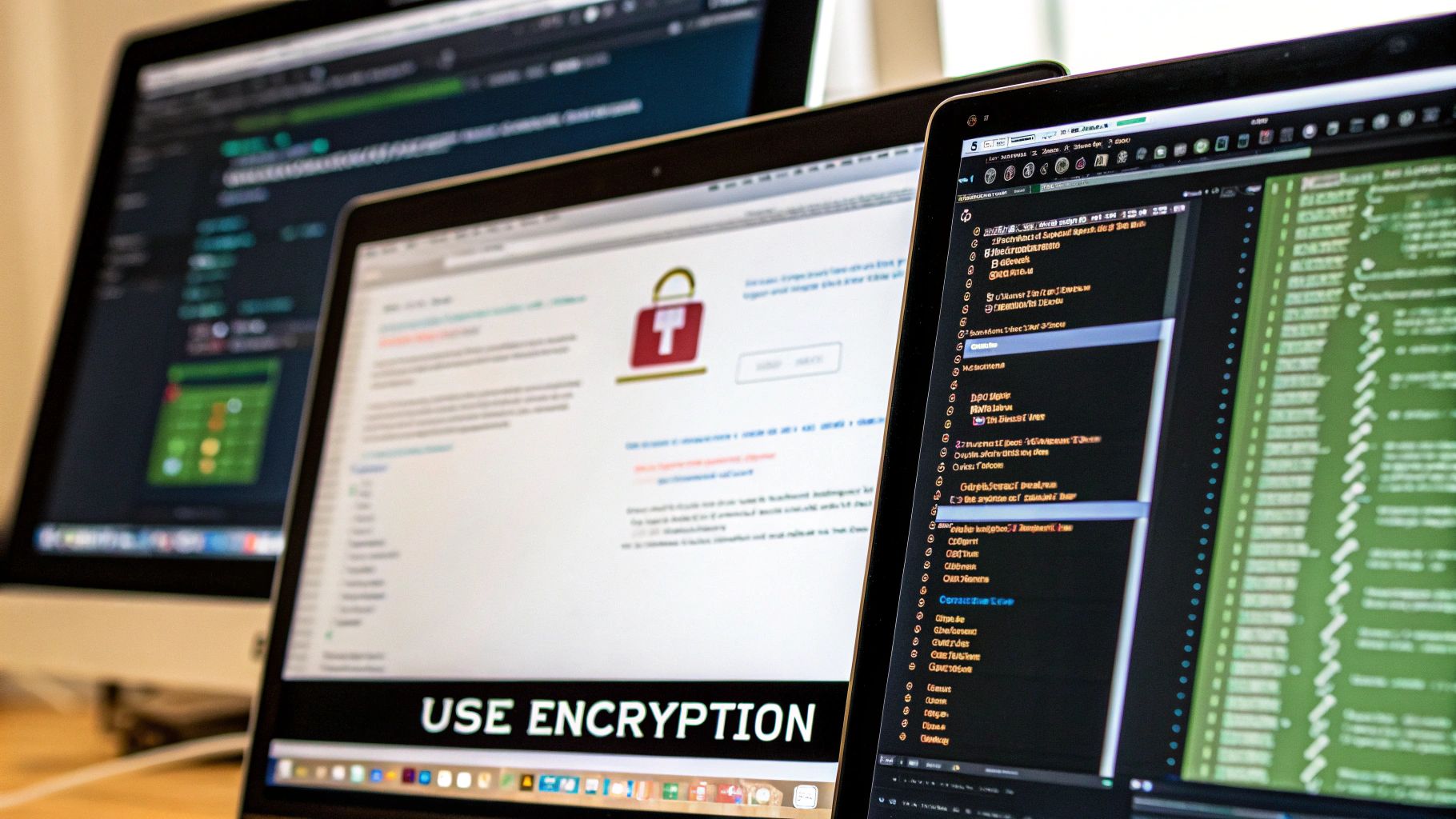Address
Australia, Singapore, and USA
Address
Australia, Singapore, and USA

Learn proven secure file sharing strategies to protect your data and ensure seamless, trusted collaboration. Discover how to keep files safe today!
It’s an uncomfortable truth: many teams think their file-sharing habits are safe, but they’re often using methods with serious security holes. Attaching files to emails or using basic cloud storage might feel easy, but they don’t provide the protection needed for sensitive information. Think of it like sending a postcard instead of a sealed, tracked letter—anyone along the route can potentially peek at the contents.
This gap between how secure we feel and how secure we are is a huge risk. For instance, a marketing team might share a confidential campaign strategy with a generic cloud link, not realizing it can be forwarded or accessed by anyone who stumbles upon it. This kind of accidental exposure happens all the time.
Even popular, trusted platforms have their limits. The real danger isn’t the tool itself, but how it’s used. Without the right controls, your data is far more exposed than you might think. Here are the key vulnerabilities:
This growing awareness of data risks is exactly why the demand for true secure file sharing is on the rise. The market was valued at around $15 billion in 2025 and is expected to grow significantly. You can explore more about this market expansion from recent analyses to see just how important this has become.
Picking the right platform for sharing files securely isn’t about choosing the most famous brand. It’s about matching a service’s features to your real-world risks. A small creative agency might just need something simple with basic encryption, but a financial advisor handling sensitive client data needs ironclad security and features that prove compliance. You have to look past the flashy marketing and figure out what actually solves your problems, like stopping a file from being forwarded or blocking unauthorized downloads.
To get a clear picture of the dangers you’re up against, it helps to know where attacks are coming from. This infographic breaks down the most common threats companies face when it comes to file sharing.

The data makes it obvious: phishing is the number one threat at 50%, so any secure file sharing solution worth its salt has to protect users from clicking on tricky links or downloading malicious files. And while we spend a lot of time worrying about hackers, insider threats account for a significant 20% of incidents. It’s a reminder that security has to work from the inside out, too.
For anyone dealing with large, complex files, you might find our guide on how to share large video files helpful. It offers tips for keeping your content safe without sacrificing quality.

Rolling out a secure file sharing platform is more than just flipping a switch. It requires a thoughtful setup that prevents future headaches. The goal is to find that sweet spot between tight security and easy access. If your system is too much of a pain to use, people will find their own ways around it—like falling back on personal email—and that defeats the whole purpose.
A great setup starts with a solid plan. Instead of giving everyone the keys to the kingdom, you should create different levels of access. For instance, the finance team might only need to “view” marketing materials, but the design team will need full editing permissions. This principle of least privilege is one of your best defenses against data leaks, whether they’re accidental or intentional.
Automating your security policies is another game-changer. A good system should let you:
This kind of strategic thinking is becoming standard practice, especially as the market for these tools explodes. The global secure file transfer market was valued at $2.4 billion in 2024 and is projected to hit $3.7 billion by 2033. You can read more about these secure file transfer market trends to see what’s driving this growth.
Beyond the tools themselves, truly secure file sharing comes down to smart, consistent habits. Professionals treat security as an active process, not just a one-time setup. This means looking past strong passwords and considering the entire journey of a file. For instance, when a new person joins your team, do you just hand over the keys to everything? A pro assigns permissions based strictly on what that person needs to do their job, nothing more.
This careful approach makes a huge difference in day-to-day work. Here are a few key practices that should be second nature:
This visual from Wikipedia’s page on computer security illustrates the core ideas of protecting information.
The diagram makes it clear that security isn’t just one thing; it’s a series of layers working together, from physical access to administrative rules. Juggling all these moving parts, especially when you’re dealing with very large documents, demands a solid strategy. For more on that, check out our guide on how to transfer large files safely and efficiently.

Juggling compliance rules like GDPR and HIPAA can feel like you’re trying to solve a puzzle with constantly changing pieces. But it doesn’t have to be a nightmare. The key is to stop seeing compliance as a roadblock and start treating it as a roadmap for building trust with your clients and partners.
Think about it from a customer’s perspective. When a healthcare provider uses secure file sharing for patient records, they aren’t just ticking a box to satisfy HIPAA. They’re actively demonstrating that patient privacy is their top priority. A solid platform should give you a clear audit trail, showing exactly who accessed a file and when. This becomes incredibly helpful during a regulatory review.
Instead of just reacting to new regulations, you can get ahead by using them as a guide to strengthen your security practices. The market for secure file transfers is growing fast, expected to hit $5 billion by 2033, which shows that more businesses are investing in these protections. You can learn more about the secure file transfer market forecast to understand how this trend can improve your own security posture.
With tools like Sky Drive Folder, you can easily put features like data residency controls and strong encryption into practice, helping you meet these strict standards without the headache. To get a better sense of what’s required across different fields, take a look at the table below.
| Industry | Primary Regulations | Key Requirements | Common Challenges |
|---|---|---|---|
| Healthcare | HIPAA (Health Insurance Portability and Accountability Act) | End-to-end encryption, strict access controls, audit trails for Protected Health Information (PHI). | Ensuring third-party vendor compliance, managing large imaging files (MRIs, X-rays). |
| Financial Services | GLBA (Gramm-Leach-Bliley Act), SOX (Sarbanes-Oxley Act) | Secure data storage, protection of non-public personal information (NPI), data retention policies. | Proving data integrity for audits, preventing insider threats. |
| Legal | ABA Model Rules, Attorney-Client Privilege | Confidentiality of client communications, secure document handling, preventing unauthorized access. | Sharing discovery documents securely, managing version control across case files. |
| Government/Public Sector | FISMA (Federal Information Security Management Act), CMMC (Cybersecurity Maturity Model Certification) | Strong data encryption, continuous monitoring, controlled access based on clearance levels. | Handling classified information, meeting strict federal standards for data handling. |
| General Business (EU) | GDPR (General Data Protection Regulation) | Data subject rights (right to erasure), data residency controls, breach notification within 72 hours. | Managing cross-border data transfers, tracking consent for data processing. |
As you can see, while the specific rules change, the core principles of encryption, access control, and auditability are consistent. Choosing a platform designed with these requirements in mind makes it much easier to stay on the right side of regulations, no matter your industry.
Even with a top-notch system, things can get stuck. A folder suddenly won’t sync, or a colleague insists the access link you sent isn’t working. When your secure file sharing process hits a snag, it’s easy for frustration to build, but a calm, methodical approach is always the fastest way out. Before you start digging into complex settings, always start with the basics—it’s surprising how often the simplest fix is the right one.
When someone tells me they can’t access a file, I’ve learned not to jump straight to resetting all their permissions. Instead, I ask them to run through a quick checklist first. More often than not, this solves the problem right away.
This simple “triage” process usually resolves the issue in a few minutes, which is way better than opening a support ticket that takes hours. It gives the user immediate steps they can take, which helps ease their frustration while you investigate further if needed.
Putting a secure file sharing system into action is the final, crucial step. Whether you’re moving on from basic tools or swapping out an outdated system, having a clear plan makes all the difference. This isn’t just about plugging in new tech; it’s about guiding your team through the change without causing a big disruption.
For a small business, a full rollout might take just a couple of weeks, but a larger company should probably set aside a few months for the project. When budgeting, think beyond the subscription price. You’ll also need to account for potential costs like migrating data from an old system or any specialized training your team might need.
The real key to success is getting your team on board. I always suggest starting with a small pilot group of employees who are generally comfortable with new tech. Their feedback is pure gold. You can use their experience to smooth out any wrinkles in your process before you roll it out to everyone.
To keep everything moving, a simple checklist can be your best friend:
By planning your rollout with care, you can sidestep the common issues that often trip up new software implementations.
Ready to build your roadmap with a platform that combines security with simplicity? See how Sky Drive Folder gives you all the tools you need for a smooth and successful transition. Start your secure file sharing journey today.
Article created using skydrivefolder.com
It agree, rather amusing opinion
I join. It was and with me. We can communicate on this theme. Here or in PM.